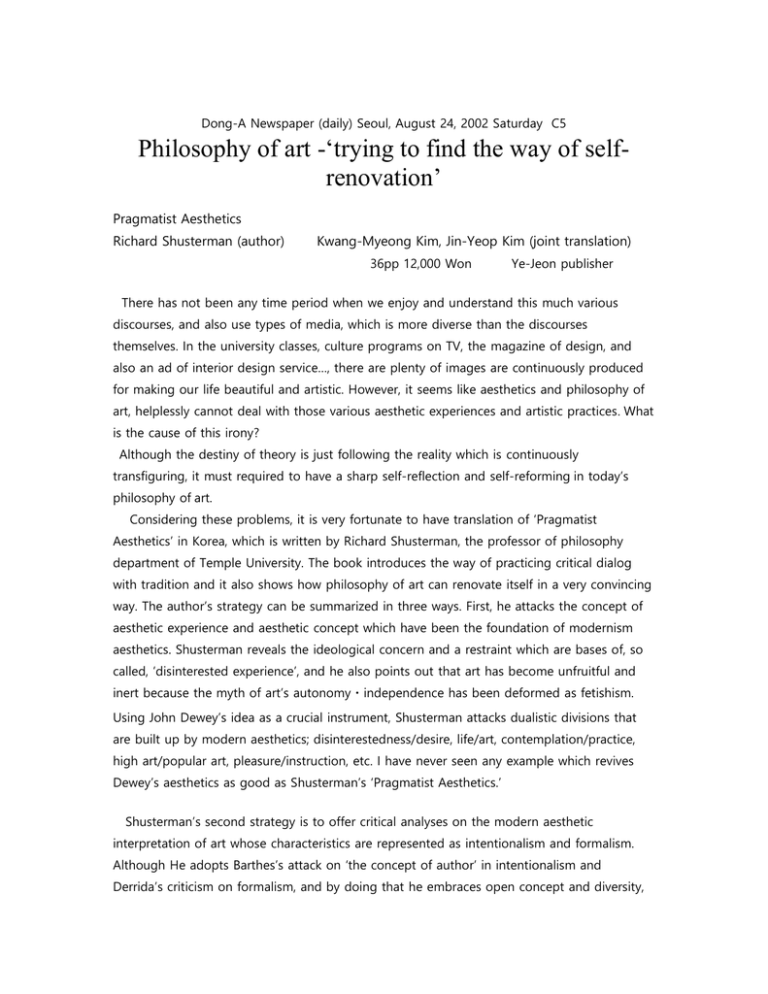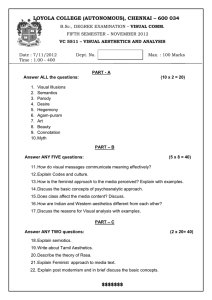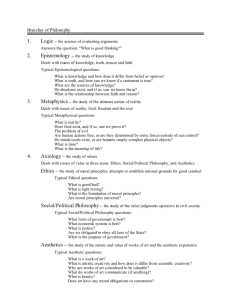Philosophy of art -‘trying to find the way of self- renovation’
advertisement

Dong-A Newspaper (daily) Seoul, August 24, 2002 Saturday C5 Philosophy of art -‘trying to find the way of selfrenovation’ Pragmatist Aesthetics Richard Shusterman (author) Kwang-Myeong Kim, Jin-Yeop Kim (joint translation) 36pp 12,000 Won Ye-Jeon publisher There has not been any time period when we enjoy and understand this much various discourses, and also use types of media, which is more diverse than the discourses themselves. In the university classes, culture programs on TV, the magazine of design, and also an ad of interior design service…, there are plenty of images are continuously produced for making our life beautiful and artistic. However, it seems like aesthetics and philosophy of art, helplessly cannot deal with those various aesthetic experiences and artistic practices. What is the cause of this irony? Although the destiny of theory is just following the reality which is continuously transfiguring, it must required to have a sharp self-reflection and self-reforming in today’s philosophy of art. Considering these problems, it is very fortunate to have translation of ‘Pragmatist Aesthetics’ in Korea, which is written by Richard Shusterman, the professor of philosophy department of Temple University. The book introduces the way of practicing critical dialog with tradition and it also shows how philosophy of art can renovate itself in a very convincing way. The author’s strategy can be summarized in three ways. First, he attacks the concept of aesthetic experience and aesthetic concept which have been the foundation of modernism aesthetics. Shusterman reveals the ideological concern and a restraint which are bases of, so called, ‘disinterested experience’, and he also points out that art has become unfruitful and inert because the myth of art’s autonomy・independence has been deformed as fetishism. Using John Dewey’s idea as a crucial instrument, Shusterman attacks dualistic divisions that are built up by modern aesthetics; disinterestedness/desire, life/art, contemplation/practice, high art/popular art, pleasure/instruction, etc. I have never seen any example which revives Dewey’s aesthetics as good as Shusterman’s ‘Pragmatist Aesthetics.’ Shusterman’s second strategy is to offer critical analyses on the modern aesthetic interpretation of art whose characteristics are represented as intentionalism and formalism. Although He adopts Barthes’s attack on ‘the concept of author’ in intentionalism and Derrida’s criticism on formalism, and by doing that he embraces open concept and diversity, he keeps himself as historicist who believes this diversity should be controlled in our tradition and discourses. His third strategy is to justify the necessity of his ‘Pragmatist Aesthetics’ by indicating in what way analytic aesthetic is not enough to treat today’s aesthetic phenomena, and mentioning how continental aesthetic discourse is deeply based on elitism. On the process of this justification, he criticizes modern aesthetics’ explicit or implicit discontents on popular art one by one. We could see the writer (Shusterman)’s professional sincerity in this argument and it is enjoyable to read his political analysis on the particular problem. Moreover, he attempts a precise interpretation on ‘Rap’ music. Via this analysis, he intends to show the alteration after avant-garde, to propose a new alternative discipline which embraces popular art, and to move on the problem of aesthetic experience which includes social practice and living expression. Of course, there are some critical problems this book has; first, he sees aesthetic modernism as well disciplined scheme. Second, he estimates badly on the cultural (ideological) critical meaning. Third, it is possible to cause theoretical vagueness because of Deweyan style extension. However, these problems are not very important if we consider the value of highly refined demonstration and critical interpretation this book could offer to the reader. Seon-Kyu Ha (Professor of Kyeong-Ju University, Department of Photography and image) English translation by Hyijin Lee





